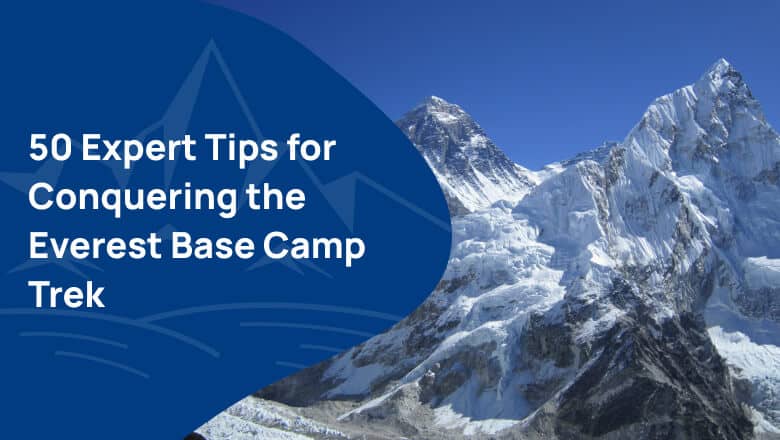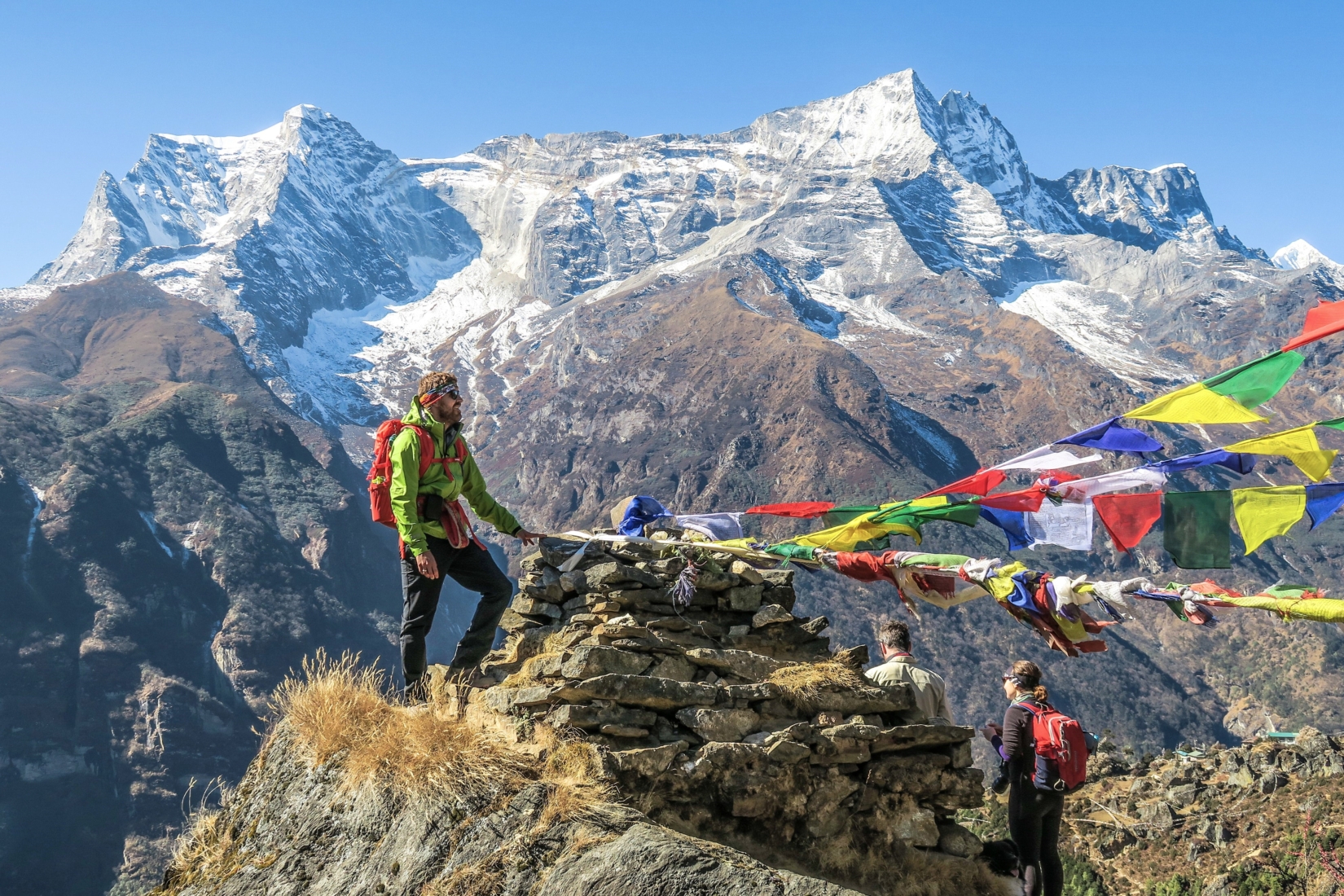Ultimate Guide to Everest Base Camp Trek 2023

If you are an adventure enthusiast seeking a once-in-a-lifetime experience, look no further than the Everest Base Camp Trek in 2023. Trekking to the base camp of the world's tallest mountain is a dream for many, and with careful planning and preparation, you can make it a reality.
Benefits of Everest Base Camp Trek 2023
-
Breathtaking Scenery: The Everest Region is renowned for its awe-inspiring views of snow-capped peaks, glaciers, and picturesque landscapes. The trek will take you through Sagarmatha National Park, a UNESCO World Heritage Site, offering glimpses of unique flora and fauna.
-
Cultural Immersion: Along the trekking trail, you will encounter local Sherpa communities, known for their warm hospitality and rich Tibetan Buddhist culture. You will be able to visit monasteries, interact with locals, and gain insights into their way of life.
-
Physical and Mental Challenge: The Everest Base Camp Trek is a physically demanding journey that will test your endurance and mental strength. Overcoming challenges and pushing your limits will give you a sense of achievement and personal growth.
Things to consider before planning the trek
-
Physical Fitness: The trek involves long hours of walking and ascending to high altitudes. Prior physical fitness preparation, including cardio and strength training, is crucial to ensure a safe and enjoyable experience.
-
Altitude Acclimatization: Proper acclimatization is essential to avoid altitude sickness. Following a gradual ascent is recommended, as taking regular rest days and staying hydrated throughout the trek.
-
Equipment and Gear: Packing the right gear, including sturdy trekking boots, warm clothing, a good quality sleeping bag, and a backpack, is essential for a comfortable and successful trek.
Embarking on the Everest Base Camp Trek in 2023 will offer you an unforgettable adventure, a chance to connect with nature and culture, and a personal triumph at the foothills of Mount Everest. Start planning and make your dream trek a reality!

Preparing for the Trek
Physical fitness requirements
Are you ready to embark on a once-in-a-lifetime adventure to the Everest Base Camp? Before you start planning your trip, assessing your physical fitness level is essential. The trek to Everest Base Camp is challenging and demands certain endurance and strength. Regular aerobic exercise like hiking, running, or cycling will help condition your body for the trek. It's also recommended to consult with a healthcare professional before undertaking any strenuous physical activity.
Packing Essentials for Everest Base Camp Trek
Packing for your Everest Base Camp trek requires careful consideration of the essentials. Here's a comprehensive list to ensure you have everything you need:
-
Clothing: Layering is key to adapting to changing weather conditions. Include warm base layers, fleece jackets, waterproof outer layers, hiking pants, thermal socks, and a good-quality down jacket.
-
Footwear: Invest in sturdy, comfortable hiking boots that provide ankle support. Don't forget to pack extra pairs of socks and blister-prevention products.
-
Gear: A good quality backpack, a sleeping bag suitable for cold temperatures, trekking poles for added stability, a headlamp, and a water filtration system are essential.
-
Medications and First-Aid: Carry your prescribed medications, along with a basic first-aid kit that includes bandages, antiseptic creams, pain relievers, and altitude sickness medication.
-
Other Necessities: Don't forget to pack sunscreen, sunglasses, a hat, gloves, a water bottle, snacks, a camera, and a portable charger.
Packaging light is key as you'll carry your backpack throughout the trek. Prioritize essentials and leave behind non-essential items.
Now that you know what to expect and how to prepare, prepare for the adventure of a lifetime on the Everest Base Camp Trek in 2023!
Choosing the Right Route
When embarking on the adventure of a lifetime, trekking to Everest Base Camp in 2023, you want to make sure you choose the right route. With so many options available, it's important to research and select the route that suits your preferences and abilities.
Different routes to Everest Base Camp
You can take several routes to reach Everest Base Camp, each offering its unique experience. The most popular routes include the Classic Everest Base Camp Trek, the Gokyo Lakes Trek, and the Jiri to Everest Base Camp Trek. All of these routes have their highlights and challenges, so it's important to consider factors such as length, altitude, and scenery when making your decision.
Comparison of popular routes: Everest Base Camp vs. Gokyo Lakes
If you're torn between the Classic Everest Base Camp Trek and the Gokyo Lakes Trek, here's a comparison to help you make up your mind:
| Route | Highlights |
|---|---|
| Everest Base Camp Trek | - Stunning views of iconic peaks such as Everest, Lhotse, and Nuptse - Trekking through traditional Sherpa villages and monasteries - Visiting the famous Tengboche Monastery- Reaching Everest Base Camp itself and standing in awe of the world's highest peak |
| Gokyo Lakes Trek | - Spectacular views of Everest, Cho Oyu, and Makalu- Discovering the pristine beauty of the Gokyo Lakes and their turquoise waters- Exploring the Ngozumpa Glacier, the largest glacier in the Himalayas- Climbing Gokyo Ri for panoramic views of the Himalayas and the famous Everest panorama |
Whichever route you choose, trekking to Everest Base Camp in 2023 promises to be an unforgettable adventure filled with breathtaking scenery and cultural immersion. Just remember to prepare well, acclimatize properly, and enjoy every step of this extraordinary journey.

Acclimatization and Altitude Sickness
Understanding altitude sickness and its symptoms
If you're planning to trek to Everest Base Camp in 2023, it's crucial to understand altitude sickness and its symptoms. Altitude sickness occurs when you ascend to high altitudes too quickly, and your body doesn't have enough time to adjust to the change in pressure and oxygen levels. Symptoms can range from mild to severe, including headaches, nausea, dizziness, fatigue, and difficulty breathing.
Awareness of these symptoms is essential because altitude sickness can be life-threatening if not addressed promptly. Monitoring your condition and those in your trekking group regularly is vital. If you or someone in your group experiences severe symptoms, it's crucial to descend to a lower altitude and seek medical attention immediately.
Tips for acclimatization during the trek
Proper acclimatization is key to a successful Everest Base Camp trek. Here are some tips to help you acclimatize effectively:
-
Take it slow: Ascend gradually, allowing your body time to adjust to the changing altitude. Plan your itinerary carefully to include rest and shorter hiking days to give your body time to acclimate.
-
Stay hydrated: Drink plenty of water to prevent dehydration and help your body adjust to the altitude. Avoid alcohol and caffeine, as they can increase dehydration.
-
Listen to your body: Pay attention to any symptoms of altitude sickness and communicate with your trekking guide. Don't push yourself too hard, and be open to adjusting your trekking plans if necessary.
-
Consider medication: Consult with your doctor or travel clinic about taking medication to prevent altitude sickness. Medications like acetazolamide can help with acclimatization.
Remember, acclimatization is essential for a safe and enjoyable trek. Take your time, enjoy the journey, and prioritize your health and well-being.

Accommodation and Food
Planning a trek to Everest Base Camp in 2023? Here's the ultimate guide to help you prepare for an unforgettable adventure!
Types of accommodation available on the trek
During your Everest Base Camp trek, you'll find various accommodation options for different budgets and preferences. The most common types of accommodation include teahouses, lodges, and camping.
Teahouses are the most popular choice among trekkers. These local guesthouses provide basic facilities such as a bed, blanket, and meals. Lodges, on the other hand, offer slightly more amenities like private rooms and attached bathrooms. Camping is an option if you prefer a more immersive experience with nature.
It's important to note that accommodation facilities may vary along the trek, with teahouses being more readily available in the lower altitudes and becoming more basic as you ascend. Book your accommodation in advance during peak trekking seasons to secure a spot.
Local cuisine and food options
Nepalese cuisine offers various flavours to satisfy your taste buds during the trek. Local teahouses and lodges serve various dishes, including traditional Nepali dal bhat (rice and lentils), momo (dumplings), Sherpa stew, and yak-based dishes.
While trekking, it's important to maintain a balanced diet and stay hydrated. It's advisable to carry energy bars, snacks, and water purification tablets with you. Drinking plenty of water and eating hot meals can help prevent altitude sickness and energise you throughout your journey.
Remember, food options may become more limited and basic as you reach higher altitudes. It's always a good idea to inform your accommodation providers about any dietary restrictions or allergies you may have to ensure a comfortable and enjoyable trek.
So, lace up your boots, pack your bags, and prepare for an epic adventure to Everest Base Camp in 2023, where breathtaking landscapes and delicious local cuisine await you!

Highlights of the Trek
Scenic views and landmarks on the trek
Embarking on the Everest Base Camp Trek in 2023 is a once-in-a-lifetime experience that will leave you in awe. The journey offers breathtaking views of the majestic Himalayan range, including towering peaks like Mount Everest, Lhotse, and Ama Dablam. The trail takes you through picturesque villages, lush forests, and cascading waterfalls, providing an unparalleled opportunity to immerse yourself in the region's natural beauty.
As you trek higher, you will encounter iconic landmarks such as the famous Tengboche Monastery, known for its spiritual significance and stunning backdrop of snow-capped mountains. The Everest Base Camp is a major highlight, where you can witness the sheer magnificence of the world's highest peak up close.
Opportunities for photography and sightseeing
For photography enthusiasts and nature lovers, the Everest Base Camp Trek is a dream come true. The trail presents countless opportunities to capture postcard-worthy landscapes, dramatic sunrises and sunsets, and unique cultural encounters. From the vibrant prayer flags fluttering in the wind to the friendly Sherpa people going about daily, every moment is a perfect opportunity to freeze-frame memories.
Along the trek, you can also indulge in sightseeing activities, visiting attractions like the Sagarmatha National Park, a UNESCO World Heritage Site known for its diverse flora and fauna. The park is home to rare species like the elusive snow leopard and the colourful Himalayan pheasant.
So, pack your bags, lace up your boots, and prepare for an unforgettable adventure on the Everest Base Camp Trek in 2023. Get ready to witness awe-inspiring views, capture stunning photographs, and create memories that will last a lifetime.

Safety and Emergency Measures
As you embark on your thrilling Everest Base Camp trek in 2023, it's crucial to prioritize safety and be prepared for any unforeseen circumstances. Here are some essential safety precautions and emergency measures to remember throughout your journey.
Safety precautions to take during the trek
1. Train and prepare: Prioritize physical fitness and endurance training before the trek. Strengthen your muscles and cardiovascular system through regular exercises and hikes.
-
Acclimatize properly: Take time to acclimatize during the trek to prevent altitude sickness. Ascend gradually, stay hydrated, and listen to your body's signals.
-
Stay hydrated and nourished: Drink plenty of water and eat nutritious meals to maintain energy levels and avoid dehydration.
-
Follow the advice of your guide: Listen to your experienced guide's instructions and follow their recommendations to ensure your safety at all times.
-
Dress appropriately: Layer your clothing to adapt to changing weather conditions. Carry essential items like waterproof jackets, hats, gloves, sunglasses, and sturdy hiking boots.
Emergency response and evacuation procedures
1. Communication: Carry a fully charged mobile phone with a local SIM card and emergency contacts saved. Make sure you have a reliable means of communication with your guide or trekking agency.
-
First aid kit: Pack a well-stocked kit with essential medications, bandages, blister treatments, and any personal medications you may require.
-
Emergency evacuation: In the event of a serious injury or illness, your guide will arrange emergency evacuation by helicopter. Ensure you have adequate travel insurance that covers emergency rescue and medical expenses.
-
Follow the evacuation plan: Stay calm and follow the instructions provided by your guide or rescue team during an emergency evacuation.
Remember, your safety is of utmost importance. By following these safety precautions and being prepared for emergencies, you can enjoy your Everest Base Camp trek while minimizing risks.

Trekking Guides and Permits
Importance of hiring a guide or porter
Embarking on the Everest Base Camp trek is an incredible adventure, but it's not without challenges. That's why it's highly recommended to hire a guide or porter. They provide invaluable assistance and make your journey more enjoyable.
-
Expertise and Safety: Local guides have extensive knowledge of the trekking routes, weather conditions, and altitude. They can help you navigate through difficult terrains and ensure your safety throughout the journey.
-
Support and Encouragement: Trekking to Everest Base Camp can be physically and mentally demanding. Having a guide or porter by your side offers moral support and encouragement, making it easier to push through tough times.
-
Cultural Insight: Guides are often from the local Sherpa community and can provide rich insights into the region's culture, traditions, and history. This enhances your overall trekking experience.
Necessary permits for Everest Base Camp Trek
Before embarking on your Everest Base Camp adventure, obtaining the necessary permits is essential. Here are the permits you will need:
-
Sagarmatha National Park Entry Permit: This permit allows you to enter the Sagarmatha National Park, where Everest Base Camp is located. It helps conserve the natural environment and ensures sustainable tourism.
-
Khumbu Pasang Lhamu Rural Municipality Entry Permit: This permit is required to enter the Khumbu region, which includes popular trekking destinations like Namche Bazaar and Tengboche. It supports local development projects in the area.
-
TIMS Card (Trekkers' Information Management System Card): The TIMS Card is a trekking permit that provides emergency and security services to trekkers. It helps track your movements during the trek and ensures your safety.
Remember to carry these permits with you at all times during your trek. They are essential documents that grant you access to the breathtaking landscapes of Everest Base Camp.

Budgeting and Costs
Estimated budget for Everest Base Camp Trek
If you've ever dreamed of trekking to Everest Base Camp, planning your budget ahead of time is important. While costs can vary depending on factors such as the duration of your trip and the level of comfort you prefer, here is an estimated breakdown of expenses:
-
Flights: The journey to Lukla, the starting point of the trek, typically involves a flight from Kathmandu. Budget around $150 to $200 for a round-trip ticket.
-
Permits and fees: To enter the Sagarmatha National Park and trek to Everest Base Camp, you must obtain permits. The cost for these permits is approximately $40 to $50.
-
Accommodation: You will stay in teahouses along the route during the trek. Expect to pay around $10 to $20 per night for a basic room.
-
Food and drink: Meals can be purchased at teahouses along the way. Budget around $10 to $20 per day for food and drink.
-
Guides and porters: Hiring a guide or porter is optional but recommended, especially if you're new to trekking or want assistance with your gear. This can cost anywhere from $20 to $30 per day.
Additional expenses to consider
In addition to the above costs, there are a few other expenses to keep in mind:
-
Gear: If you don't have all the necessary trekking gear, you might need to purchase or rent hiking boots, a down jacket, and a sleeping bag.
-
Travel insurance: It's highly recommended to have travel insurance that covers medical emergencies and evacuation in case of any unforeseen circumstances.
-
Tips: It's customary to tip your guide and porter at the end of the trek as a token of appreciation for their services.
Budgeting and considering these costs in advance ensures that your Everest Base Camp trek in 2023 is an enjoyable and unforgettable experience.
Tips for a successful and enjoyable trek in 2023
-
Train and prepare: The trek to Everest Base Camp is physically demanding. Train beforehand by hiking, jogging, or doing regular cardio exercises. Additionally, acclimatization is crucial, so consider spending a few days in higher altitude areas before starting the trek.
-
Get proper gear: Invest in quality trekking gear, including sturdy hiking boots, layered clothing for changing weather conditions, a good backpack, and a sleeping bag suitable for cold temperatures.
-
Stay hydrated and eat well: Drink plenty of water to prevent altitude sickness and maintain a balanced diet with enough calories to fuel your trek. Local cuisine can be a delightful and nourishing experience, so don't miss out on trying traditional Nepalese dishes.
-
Take your time and enjoy the journey: Trekking to Everest Base Camp is not a race. Take breaks, soak in the breathtaking views, and interact with fellow trekkers and locals. It's not just about reaching the destination but also about the incredible experiences along the way.
-
Respect the environment and local culture: Preserve the pristine beauty of the Everest region by following the Leave No Trace principles. Show respect to local customs and traditions, and be mindful of the impact of your actions on the local community and ecosystem.
Remember, embarking on the Everest Base Camp trek is challenging but immensely rewarding. With proper preparation, a positive mindset, and a spirit of adventure, you'll have a truly unforgettable experience in 2023. Happy trekking!
